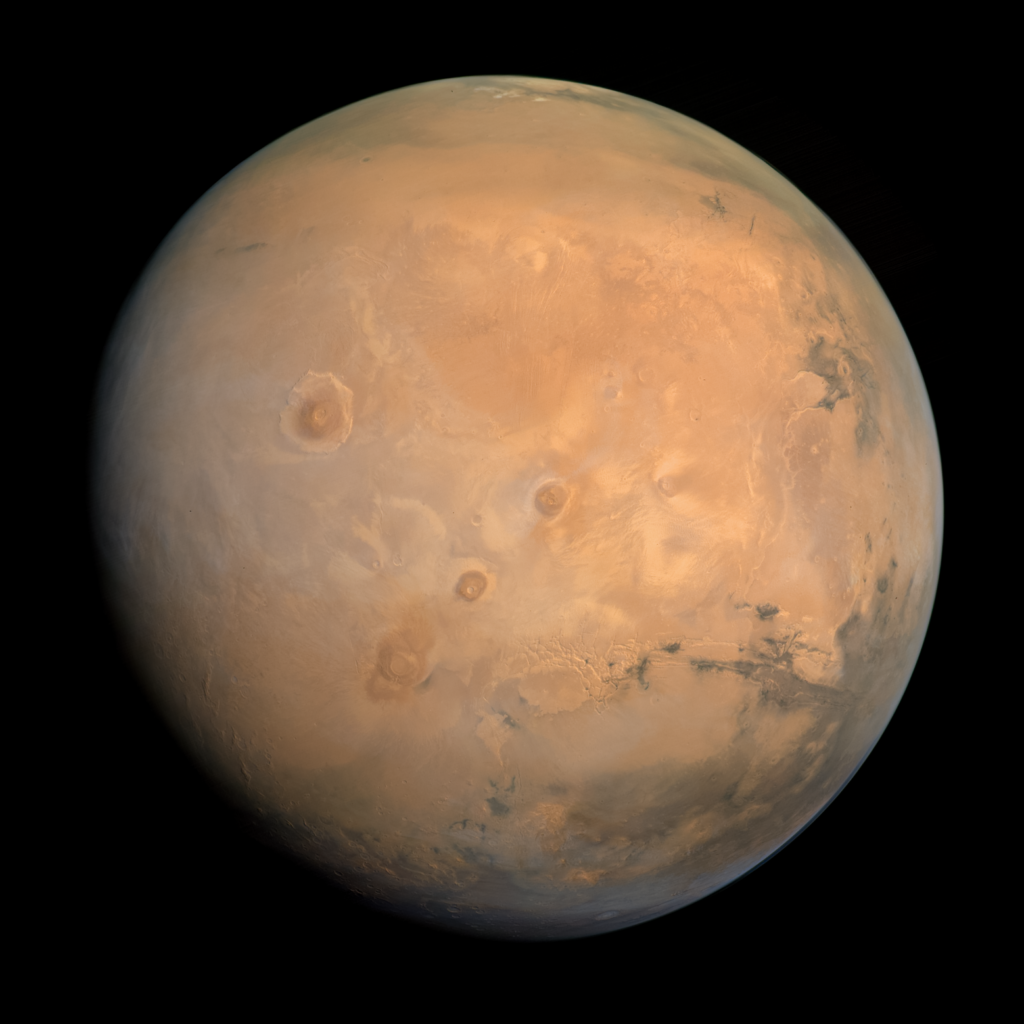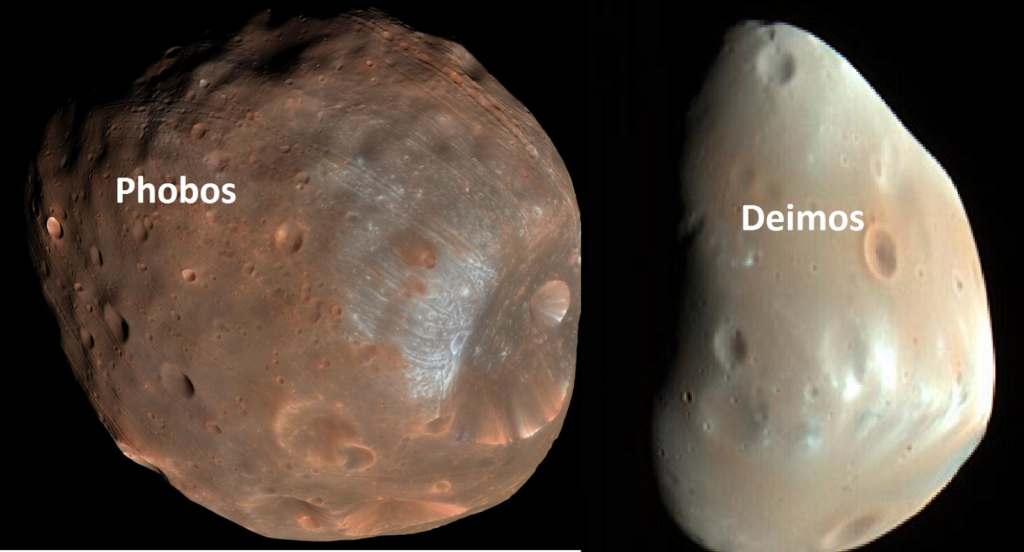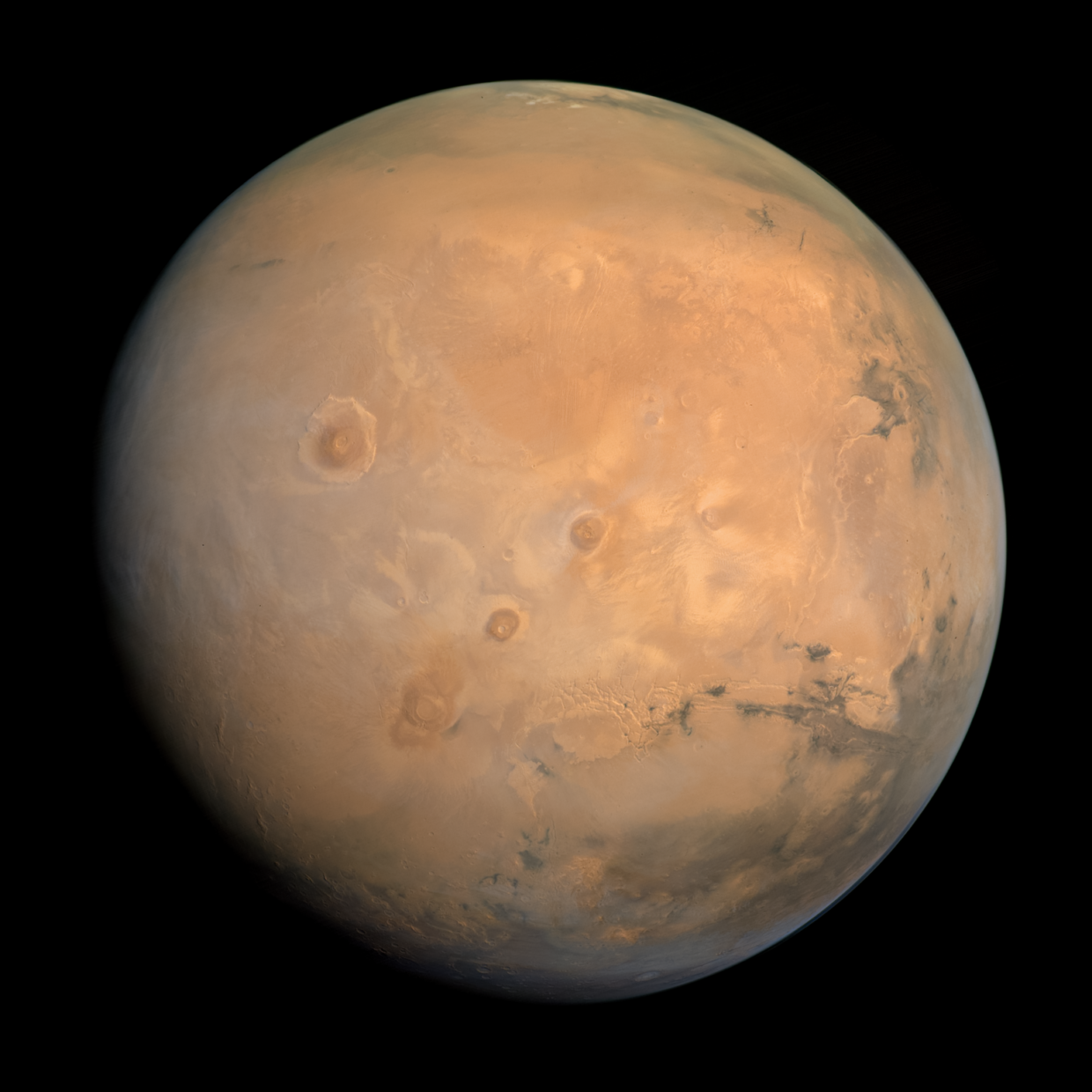Mars is the fourth planet from the Sun, and the seventh largest. It’s the only planet we know of inhabited entirely by robots! The surface of Mars is orange-red because it is covered in iron(III) oxide dust, giving it the nickname “the Red Planet”. Mars hosts many enormous extinct volcanoes and one of the largest canyons in the Solar System.

Gravity: 3.71 m/s²
Orbital period: 687 days
Length of day: 1d 0h 37m
Radius: 3,389.5 km
Distance from Sun: 227.9 million km
Coordinates: RA 19h 47m 43s | Dec -22° 1′ 44″
This is a LIVE video of Mars from NASA that I screen-recorded! This resource allows learners to explore tools such as the planet size comparison (I show in this video!!), distance between planets, and explorations that have occurred on Mars!
Mars is like the solar system’s adventure playground! It’s the only place where our cool robot rovers get to explore. NASA found clues that Mars used to be way wetter and warmer, with a thicker atmosphere, billions of years ago. The name “Mars” comes from the Romans, who thought its reddish color looked like blood, naming it after their god of war. The Egyptians called it “Her Desher,” meaning “the red one.” Even today, we still call it the “Red Planet” because the dirt on Mars has a lot of iron that rusts, making everything look red.
Size and Distance
Having a radius of 2,106 miles (3,390 kilometers), Mars is roughly half the size of Earth. To put it in perspective, if Earth were the size of a nickel, Mars would be comparable to a raspberry. Situated at an average distance of 142 million miles (228 million kilometers) from the Sun, Mars is positioned 1.5 astronomical units away. An astronomical unit (abbreviated as AU) is the distance between the Sun and Earth. Within this span, it takes sunlight approximately 13 minutes to make the journey from the Sun to Mars.
Orbit and Rotation
As Mars travels around the Sun, it completes a full rotation approximately every 24.6 hours, quite similar to Earth’s day, which lasts 23.9 hours. These Martian days are known as “sols,” a term derived from “solar day.” A Martian year spans 669.6 sols, equivalent to 687 Earth days. Mars tilts on its axis by 25 degrees concerning the plane of its orbit around the Sun, resembling Earth’s axial tilt of 23.4 degrees. This tilt results in distinctive seasons on Mars, although they endure for a more extended period compared to Earth due to Mars’ greater orbital distance. Unlike Earth, where seasons evenly last for three months (or a quarter of the year), Mars experiences varying season lengths because of its elliptical, egg-shaped orbit around the Sun. In the northern hemisphere (southern autumn), spring is the lengthiest season at 194 sols. On the other hand, autumn in the northern hemisphere (southern spring) is the shortest, lasting for 142 sols. The northern winter/southern summer spans 154 sols, while the northern summer/southern winter extends over 178 sols.
Moons

Phobos, Mars’ innermost and more substantial moon, displays a terrain marked by numerous craters and deep grooves. Gradually, it is approaching Mars and is anticipated to collide with the planet or disintegrate in approximately 50 million years.
In contrast, Deimos, which is roughly half the size of Phobos, orbits Mars at a distance two and a half times greater. Deimos has an unusual shape and is covered in loose soil, often filling its craters, resulting in a smoother appearance compared to the pitted surface of Phobos.
Exploration
This is a table taken directly from NASA. “No planet beyond Earth has been studied as intensely as Mars.”
| Launch Date | Spacecraft | Nation | Goal | Result |
|---|---|---|---|---|
| Oct 10, 1960 | 1M No. 1 | USSR | Mars Flyby | Unsuccessful |
| Oct 1, 1960 | 1M No. 2 | USSR | Mars Flyby | Unsuccessful |
| Oct 24, 1962 | 2MV-4 No. 1 | USSR | Mars Flyby | Unsuccessful |
| Nov 1, 1962 | Mars 1 | USSR | Mars Flyby | Unsuccessful |
| Nov 4, 1962 | 2MV-3 No. 1 | USSR | Mars Lander | Unsuccessful |
| Nov 5, 1964 | Mariner 3 | USA | Mars Flyby | Unsuccessful |
| Nov 28, 1964 | Mariner 4 | USA | Mars Flyby | First Successful Mars Flyby |
| Nov 30, 1964 | Zond 2 | USSR | Mars Flyby | Unsuccessful |
| Feb 25, 1969 | Mariner 6 | USA | Mars Flyby | Unsuccessful |
| Mar 27, 1969 | 2M No. 521 | USSR | Mars Orbit | Unsuccessful |
| Mar 27, 1969 | Mariner 7 | USA | Flyby | Successful |
| Apr 2, 1965 | 2M No. 522 | USSR | Mars Orbit | Unsuccessful |
| May 9, 1971 | Mariner 8 | USA | Mars Orbit | Unsuccessful |
| May 10, 1971 | Kosmos 419 | USSR | Mars Orbit | Unsuccessful |
| May 19, 1971 | Mars 2 | USSR | Mars Orbit & Landing | Partial Success; First Mars Impact |
| May 28, 1971 | Mars 3 | USSR | Mars Orbit & Landing | Partial Success; First Soft Landing on Another Planet |
| May 30, 1971 | Mariner 9 | USA | Mars Orbit | Successful; First Spacecraft to Orbit Another Planet |
| Jul 21, 1973 | Mars 4 | USSR | Mars Orbit | Partial Success |
| Jul 25, 1973 | Mars 5 | USSR | Mars Orbit | Successful |
| Aug 5, 1973 | Mars 6 | USSR | Mars Flyby & Landing | Partial Success |
| Aug 9, 1973 | Mars 7 | USSR | Mars Flyby & Landing | Partial Success |
| Aug 20, 1975 | Viking 1 | USA | Mars Orbit & Landing | First Successful Mars Lander |
| Sep 9, 1975 | Viking 2 | USA | Mars Orbit & Landing | Successful |
| Jul 7, 1998 | Phobos 1 | USSR | Phobos Orbit & Landing | Unsuccessful |
| July 12, 1988 | Phobos 2 | USA | Mars Orbit & Landing | Unsuccessful |
| Sep 25, 1992 | Mars Observer | USA | Mars Orbit | Unsuccessful |
| Nov 7, 1996 | Mars Global Surveyor | USA | Mars Orbit | Successful |
| Nov 16, 1996 | Mars 96 | USSR | Mars Orbit, Landing & Impact | Unsuccessful |
| Dec 4, 1996 | Mars Pathfinder | USA | Mars Lander & Rover | First Successful Rover on Another Planet |
| Jul 3, 1998 | Nozomi | Japan | Mars Orbit | Unsuccessful |
| Dec 11, 1998 | Mars Climate Orbiter | USA | Mars Orbit | Unsuccessful |
| Jan 3, 1999 | Mars Polar Lander / Deep Space 2 | USA | Mars Orbit & Impact | Unsuccessful |
| Apr 7, 2001 | Mars Odyssey | USA | Mars Orbit | Successful |
| Jun 2, 2003 | Mars Express / Beagle 2 | ESA | Mars Orbit & Landing | Partial Success |
| Jun 10, 2003 | Spirit | USA | Mars Rover | Successful |
| Jul 8, 2003 | Opportunity | USA | Mars Rover | Successful |
| Mar 2, 2004 | Rosetta / Philae | ESA | Mars Gravity Assist | Successful |
| Aug 12, 2005 | Mars Reconnaissance Orbiter | USA | Mars Orbit | Successful |
| Aug 4, 2007 | Phoenix | USA | Mars Landing | Successful |
| Sep 27, 2007 | Dawn | USA | Mars Gravity Assist | Successful |
| Nov 8, 2011 | Phobos-Grunt / Yinghuo-1 | Russia / China | Mars Orbit | Unsuccessful |
| Nov 26, 2011 | Curiosity | USA | Mars Rover | Successful |
| Nov 5, 2013 | Mars Orbiter Mission | India | Mars Orbit | Successful |
| Nov 18, 2013 | MAVEN | USA | Mars Orbit | Successful |
| Mar 14, 2016 | ExoMars Trace Gas Orbiter / Schiaparelli | ESA | Mars Orbit & Landing | Partial Success |
| May 5, 2018 | Insight / Mars Cubesat One | USA | Mars Landing & Flyby | Successful |
| Jul 19, 2020 | Hope | United Arab Emirates | Mars Orbit | Successful |
| Jul 27, 2020 | Tianwen-1 | China | Mars Orbiters, Landers & Rover | Successful |
| Jul 30, 2020 | Perseverance / Ingenuity | USA | Mars Rover & Helicopter | Successful; First Powered Flight on Another Planet |
This is crazy footage of Mars! https://science.nasa.gov/mars/
https://science.nasa.gov/mars/
https://en.wikipedia.org/wiki/Mars
